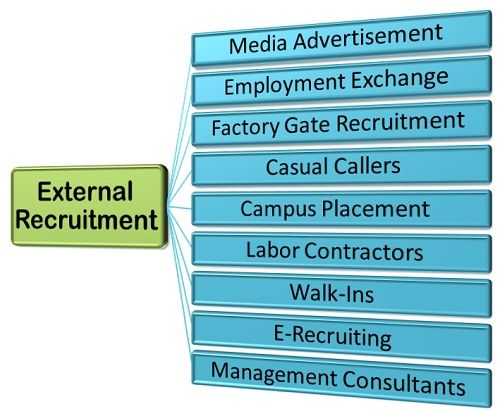
Different Sources of Recruitment - Definition, Classification, Merits, Demerits, Alternatives - The Investors Book
Sources of Recruitment
Definition: Sources of Recruitment can be viewed as various means of connecting the job seekers to the organisation which have suitable job openings. In simple words, it serves as a medium for communicating or advertising the vacant positions in the organisation to get a response from the prospective candidates.
The recruiters have to be very careful while selecting any particular source of recruitment.
The selection of a specific source of recruitment depends upon the number of personnel to be recruited, the cost involved in each source, accessibility of the applicants, education level of employees to be hired, company’s policy, etc.
The various sources of recruitment can be broadly divided into two types, which are explained in detail below:
Content: Sources of Recruitment
Internal Sources of Recruitment
Internal sources of recruitment refer to seeking the employees from within the organisation to fill up the vacant position. Many companies consider internal recruitment as a great option since it is cost-effective, and they tend to hire employees who have a better know how the organisation and its policies.
Internal recruitment can be done through the following means:
Previous Applicants: To fill up the immediate openings, calling up or emailing the candidates who have previously applied to the organisation is the cheapest and quickest source of recruitment.
Present Employees: The recruiter can exercise promotion (to a higher position) or transfer (inter-department or inter-branch transfer) of the current employees instead of recruiting the new employees.
Employee Referrals: Sometimes, the organisation hires the candidates referred by the existing employees assuming that such candidates are more trustworthy and reliable.
Former Employees: Some organisations provide for an option of re-joining to its ex-employees. They even consider the retired employees who are willing to give their full time or part-time services to the organisation.
Merits and Demerits of Internal Sources of Recruitment
The internal sources of recruitment are beneficial to the small-sized organisation dealing in the limited product line, which does not require much expertise. The organisation shouldn’t be frequently exposed to technological changes.
Read below, to have a better understanding of the related benefits and drawbacks:
Merits of Internal Sources of Recruitment
Following are some of the plus points of internal sources of recruitment:
- Internal recruitment motivates employees to perform better and get promoted.
- Employees tend to have a long-term association and develop loyalty towards the organisation.
- These sources do not involve much cost and are based on internal advertisement and mouth to mouth publicity.
- It does not require much expertise and is a more straightforward process.
- The organisation can trust the workforce so recruited since they are pre-known to the company.
- It saves time spent on scrutinising of application and training and orientation later on.
Demerits of Internal Sources of Recruitment
Although there are some drawbacks to internal recruitment too. These are discussed below:
- Internal recruitment makes it challenging to introduce new resources who think differently, to the organisation.
- Employees sometimes witness biasedness and partiality in promotion or transfer, which leads to dissatisfaction.
- It is not suitable for all types of job openings.
- It leads to conflicts when one employee is promoted, and the other is not.
External Sources of Recruitment
External sources of recruitment signify the hiring of those employees who have never been associated with the organisation before.
The organisation needs to include new and fresh talent to become successful and to survive in the competition. Large organisations mostly depend on external sources of recruitment.
Following are the various external sources through which the organisation acquire new resources:
Advertisements: The organisation advertises the job openings in the newspaper, media, company’s bulletin, social networking sites (Facebook, LinkedIn, Twitter), job portals, etc.
Campus Recruitment: The organisation collaborates with the educational institutes and colleges to hire their students for the available job vacancies, by conducting the recruitment process in the respective college campus.
E-Recruitment: The organisation uses the web-based software as a source of recruitment involving electronic screening of candidates, online skill test, online profile checks and interviews on video-conferencing.
Employment Exchange: The organisation gets itself registered with the employment exchange, i.e. a government-affiliated agency who have a database of many prospective candidates. These candidates register with such employment exchanges in search of better job opportunities.
Outsourcing Consultancies: Some private consultancies are professionally working to recruit employees on behalf of the organisation. The organisation hires such consultants on a commission basis to acquire the desired human resource.
Walk-ins and Write-ins: The organisations without any effort, get random applications when the job seekers submit their CV. Either by visiting the organisation, posting the letter with CV or mailing the CV on the company’s mail id.
Contractors: The organisation hires a contractor who provides casual workers temporarily, especially for a particular project, and such workers have no existence in the company’s records.
Acquisition and Mergers: At the time of the company’s merger or acquisition of another company; it has to lay off some of its employees as well as recruit new talents. The company structure changes drastically.
Professional Associations: Professional associations facilitates the organisation to fill in the vacant position by advertising it in their journal or magazines. It also offers job opportunities to the highly educated, skilled or experienced resources who are experts in their fields and hold a membership with such associations.
Merits and Demerits of External Sources of Recruitment
External recruitment is the best means of recruitment for the medium or large organisations, diversified into many lines of business and carrying out the bulk-hiring of employees.
Various merits and demerits of selecting external sources of recruitment have been discussed further.
Merits of External Sources of Recruitment
To understand the need for external recruitment, let us go through its benefits:
- External recruitment gives a fair chance to the applicants to compete and secure their position in the organisation.
- It is not a confidential process and ensures transparency.
- Recruiting externally promotes and encourages the intake of new and fresh talent in the organisation.
- It is widely applicable to vacancies in all type of departments for different business processes.
- The employees recruited will come up with new and innovative ideas as well as will know new technology and skills. All this initiates organisational success.
Demerits of External Sources of Recruitment
External sources though provide the organisation with a pool of applications, it has certain drawbacks too. To know more, read below:
- The existing employees may feel less valued and defeated and may even quit their jobs.
- External recruitment is a lengthy process right from identifying the human resources requirement, to scrutinising of applications.
- It involves enormous cost incurred on the advertisements, employment exchange, consultancies, etc.
- The employees who are already working in the organisation feel dissatisfied and demotivated if a senior post is filled up by an outsider.
- The existing employees fear the loss of the job or their replacement on not fulfilling the performance standards.
Alternatives to Recruitment
Recruitment has some disadvantages; for instance, it is a lengthy process and less cost-effective. Therefore, many companies opt for other options instead of hiring, to get the work done, though some of these alternatives are a temporary solution.
Let us now learn about some of the recruitment alternatives in detail:
- Outsourcing: When the organization develops a vacant position, it outsources the hiring process to a third party which is specialised in recruitment services.
- Employee Overtime: During the peak time, when the production increases gradually, the organisation demands overtime from the employees in return for additional wages.
- Temporary Employees: The organisation at times, hire temporary employees through employment agencies to cope up with the workload in peak times. Such employees can be any technicians, professionals or executives and are experienced personnel available at lower wages.
- Employee Leasing: The leasing companies lease out the services of their personnel to the organisation. They are responsible for maintaining the employees’ payroll, and in return, they get fees from the organisation.
Conclusion
In today’s world, everyone wants to be employed irrespective of their gender or caste. Technological advancement has simplified the job search even more.
The emergence of the digital era has facilitated the candidates to find new jobs, anytime and anywhere easily. Even the companies have access to better talent acquisition and a broader scope of searching for new talent from around the world.
The organisations have to wisely select a source of recruitment to make the recruitment process effective.










